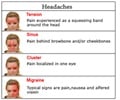Migraines and other headache disorders that affect nearly half of the adult population in the world exact heavy economic and societal costs, reports the World Health Organization.

A headache is dismissed more often than not, being under-recognized, under-diagnosed and under-treated, and there is very minimal awareness about their heavy costs, states the WHO. Lost productivity in the work front because of headache disorders means financial burdens on the economy. About 190 million days are lost every year in the EU because of migraine. It is the most expensive disorder both in the EU and the US. In the EU alone, the total annual cost of all headaches is 155 billion euros ($229 billion).
Migraine attacks make 90 per cent of people around the world postpone their house work; many find their ability severely restricted; and half of them miss work completely. And yet, only four hours of study focus on headache disorders in formal undergraduate medical training, and lack of education is the primary cause in a lack of good management of headache.
Governments must take the issue more seriously, introducing policies to train health personnel in headache disorder diagnosis and treatment, and to see that medication is available and used properly, recommends the WHO’s director of mental health and substance abuse disorders, Dr Shekhar Saxena.
Extensive research is yielding good results and in a recent study a genetic risk factor linked with common migraines has been identified that could help in developing new treatments to prevent migraine attacks.
Advertisement
Advertisement













